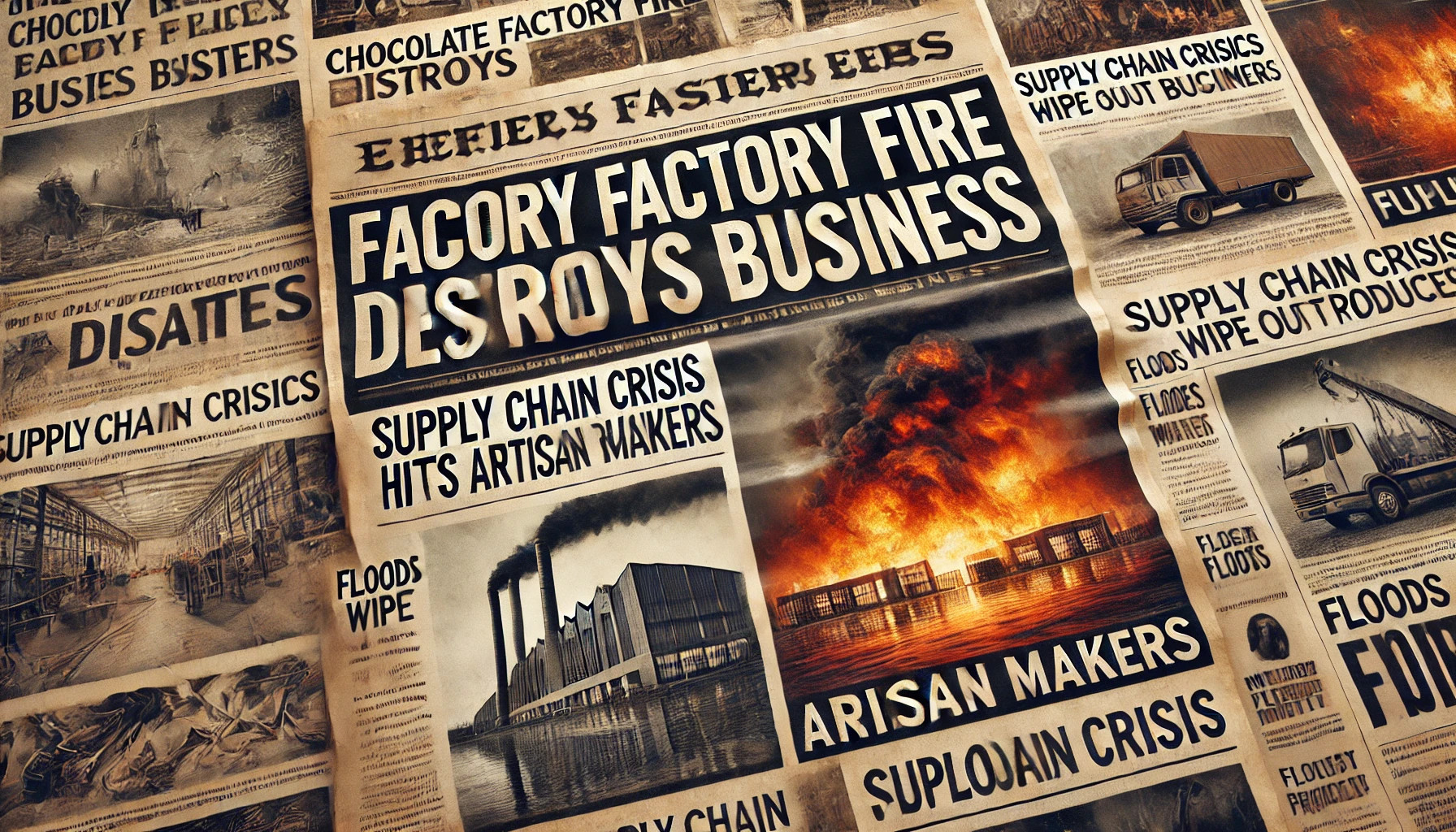 Twelve weeks into what seemed like the perfect job, my world changed overnight. I had been headhunted for a senior role at a thriving, £25 million turnover bakery business—good terms, great prospects, and a fantastic team.
Twelve weeks into what seemed like the perfect job, my world changed overnight. I had been headhunted for a senior role at a thriving, £25 million turnover bakery business—good terms, great prospects, and a fantastic team.
Then, one Friday evening, my director called and told me to turn on the news. I watched in disbelief as my office burned to the ground. Just like that, over 100 people, myself included, were unemployed.
We had no disaster recovery plan, no backup strategy—just the harsh reality of starting over.
For small artisan chocolate makers, disaster planning often takes a back seat to the daily demands of sourcing cocoa, refining recipes, and perfecting products.
However, unexpected events—whether natural disasters, supply chain disruptions, equipment failures, or financial crises—can threaten the survival of even the most well-run chocolate businesses.
The reality is you can’t afford not to plan for disasters. A well-thought-out contingency strategy can mean the difference between a temporary setback and a business-ending catastrophe.
1. Understanding the Risks
a) Natural Disasters & Climate Change
Flooding, fires, and extreme weather events can damage stock, disrupt production, and destroy facilities.
Climate change affects cocoa-growing regions, leading to supply shortages and price volatility.
Power outages can halt production and cause loss of perishable ingredients.
b) Supply Chain Disruptions
Cocoa and ingredient shortages due to political instability, disease (e.g., cacao swollen shoot virus), or shipping delays.
Loss of key suppliers or farmers affecting bean quality and availability.
Rising import/export tariffs affecting costs.
c) Equipment & Facility Failures
Essential machinery breakdowns, such as grinders, conches, or tempering machines, can halt production.
Fire hazards in chocolate production (e.g., from cocoa butter, dust, or electrical faults).
Water supply issues affecting cleaning and sanitation processes.
d) Financial & Market Risks
Sudden inflation or economic downturns affecting consumer spending.
Loss of major clients or distributors.
Unforeseen cost increases in ingredients, packaging, or transportation.
e) Food Safety & Product Recalls
Contamination risks from ingredients, allergens, or bacteria.
Packaging failures leading to spoilage.
Accidental mislabelling causing regulatory compliance issues.
2. Building a Disaster Plan
a) Risk Assessment & Prevention
Conduct a business impact analysis—what happens if key parts of production stop?
Regularly inspect and maintain equipment to reduce breakdown risks.
Keep digital and physical backups of business-critical documents (e.g., HACCP plans, supplier contracts, financial records).
b) Emergency Response Plan
Establish clear procedures for different scenarios (fire, flooding, power loss, contamination, or supply chain failure).
Have emergency contact lists for suppliers, insurance providers, and key employees.
Train staff on evacuation procedures, food safety measures, and machinery troubleshooting.
c) Financial Protection
Maintain an emergency fund to cover at least three months of expenses.
Review insurance coverage—ensure it includes business interruption, equipment failure, product recalls, and liability.
Have backup agreements with multiple suppliers to avoid reliance on a single source.
d) Crisis Communication
Develop a communication plan for customers, suppliers, and staff in case of disruption.
Be transparent in case of delays, safety issues, or closures.
Keep social media and website updates ready for crisis situations.
e) Data & Technology Backup
Store inventory records, recipes, and business plans in cloud storage for easy recovery.
Ensure cyber-security measures are in place to protect financial and customer data.
3. Leveraging Competitor Collaboration for Disaster Resilience
a) Reciprocal Facility Agreements
Arrange with trusted competitors or nearby chocolate makers to use each other’s facilities in case of equipment failure or production downtime.
Set up agreements where, on their lighter production days, you can access their grinders, conches, or tempering machines—and offer them the same in return.
If your facility suffers damage (e.g., fire, flooding, or equipment breakdown), having a backup production space ensures you can still fulfil orders.
b) Shared Storage & Inventory Backup
Arrange ingredient swaps for critical shortages—if you run out of cocoa butter or sugar, a trusted competitor might have extra stock.
Store essential backup ingredients in multiple locations to avoid total loss in a disaster (e.g., keeping some raw materials at a partner’s facility).
Share emergency warehouse or refrigeration space when needed.
c) Group Buying & Cost-Sharing
Join forces to bulk-buy expensive or scarce ingredients (cocoa beans, vanilla, packaging) to secure better prices and ensure steady supply.
Consider joint investments in high-cost, low-usage machinery like a cocoa butter press or winnower.
d) Support Network for Crisis Situations
Having a network of peers allows for fast problem-solving when disasters strike.
Establish a mutual aid agreement—if a major shipment is delayed or a supplier fails, your industry contacts might have alternative sources.
Stay connected through WhatsApp groups or industry forums to get real-time updates on potential issues affecting the market.
e) Shared Workforce Pool
If a sudden labour shortage occurs (e.g., illness, strikes, or high seasonal demand), a reciprocal agreement allows sharing trained workers between businesses.
Cross-train employees so they can step in at another facility if needed.
4. Practical Steps to Implement Now
Check your insurance – Does it cover business interruption? Equipment failure? Stock loss?
Create an emergency contact list – Include alternative suppliers, machine repair technicians, and key business contacts.
Diversify suppliers– Ensure alternative cocoa sources are available.
Stock essential backups – Keep spare machine parts, extra ingredients, and alternative packaging.
Train staff – Ensure everyone knows what to do in emergencies.
Build a financial buffer – Start small, but aim for at least a three-month safety net.
Test your plan – Run through different scenarios (e.g., “What if the power goes out for 24 hours?”).
Final Thoughts: A Necessity, Not an Option
Disaster planning isn’t just about protecting your business—it’s about creating resilience within your local chocolate-making community. A single unexpected event can wipe out months of hard work, and without a contingency plan, recovery can be slow—or impossible.
Investing time and resources into disaster preparedness now can save your business later. Strong relationships with competitors-turned-allies can make all the difference when an unexpected crisis hits.
The chocolate industry thrives on collaboration as much as competition—because in the face of disaster, having a backup plan and a trusted network might be the difference between bouncing back and shutting down.
